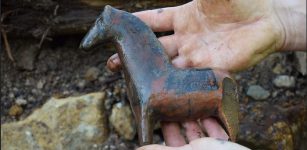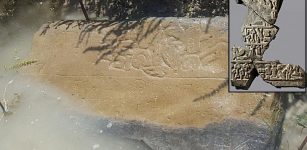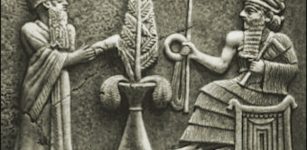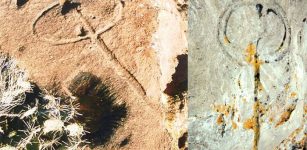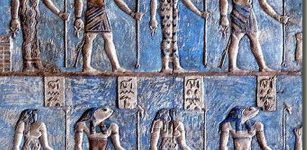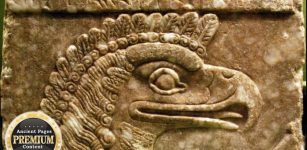Ruins Of Ancient Jerusalem Shed New Light On Earth’s Magnetic Field’s Behavior
Jan Bartek - AncientPages.com - The year was 586 B.C. and the month was August. It’s a historical date, well-remembered among people in Israel because this was when Jerusalem was destroyed by the Babylonians.
The Siege of Jerusalem is associated with King Nebuchadnezzar II, who is well known from the Bible as the Babylonian King who conquered Judah when its King, Jehoiakim, revolted in 597 BC.

The Siege and Destruction of Jerusalem. Painting by David Robert 1850. Credit: Public Domain
Under the command of Nebuchadnezzar II, Babylonian troops breached the walls of Jerusalem. Once being inside, they destroyed and burned the city, including the Holy Temple. This conquest led to the removal of many Jewish citizens who occupied Jerusalem and other Judean cities.
This horrible event is described in the Bible. The last chapter of the book of II Kings reads:
“By the ninth day [of the fourth month] the famine had become acute in the city; there was no food left for the common people. Then [the wall of] the city was breached. All the soldiers [left the city] by night through the gate between the double walls, (…) On the seventh day of the fifth month—that was the nineteenth year of King Nebuchadnezzar of Babylon—Nebuzaradan, the chief of the guards, an officer of the king of Babylon, came to Jerusalem. He burned the House of the LORD, the king’s palace, and all the houses of Jerusalem; he burned down the house of every notable person.”
It was undoubtedly one of the most dramatic events in the history of the Jewish people. Today, archaeologists who study Jerusalem’s ancient ruins can gain not only vital information about Babylonians’ conquest of Jerusalem but also information that sheds new light on the behavior of Earth’s magnetic field.
From a new study published in the journal PLOS we learn how scientists can measure the magnetic field of the ancient artifacts found at the site. The study is important not only to archaeologists and historians, but also experts focusing on Earth science.
Earth is largely protected from the solar wind, a stream of energetic charged particles emanating from the Sun, by its magnetic field, which deflects most of the charged particles.

Earth's magnetic field. Credit: NASA
For more than a century, our planet’s magnetic field has been weakening, which is not good because it makes life on the Earth vulnerable to the bombardment of vast amounts of radiation. Studies of the behavior of Earth’s magnetic field are significant and the behavior of our protective shield is constantly monitored by scientists.
Every new piece of information helps scientists to unravel the enigma of Earth’s magnetic field.
According to the lead author of the study, Yoav Vaknin from the Tel Aviv University, this is a field that “opens new horizons in the understanding of the devastation of Jerusalem, but it also offers important insights in a scientific discipline that has vast implications in many contemporary aspects of life, from navigation systems to environmental considerations.”
“Just a few steps from the Temple Mount, one prominent two-story building, probably used for administrative purposes, was also set on fire and collapsed. Over 2,600 years later, its carbonized beams and stones uncovered in the Givati parking lot excavation at the City of David National Park represent an incredibly vivid testimony of those grievous days, whose appalling events are described in the Bible.
Among the most notable remains of the building, the archaeologists noticed several fragments of a sophisticated plaster floor. Those pieces, left in the same position for millennia, proved to be essential for measuring the intensity and direction of the Earth’s magnetic field in those precise moments,” the Jerusalem Post reports.
Vaknin explained that one of the goals of this study is to understand how the magnetic field behaved in the past before direct measurement began some 400 years ago at the initiative of the captain of a British ship.
“When objects containing magnetic minerals burn at a very high temperature, those minerals are re-magnetized and therefore record the direction and the magnitude of the field in that precise moment. Artifacts like pottery, bricks and tiles, which are fired in furnaces, ovens and kilns, can all provide these records.
However, as precise as their dating can be, it usually spans of at least a few decades. On the contrary, if documented by historical records, destruction lawyers can be pinned down to a very specific moment – in the case of Jerusalem in 586 almost to the date - providing a unique opportunity,” Vaknin explained in an interview with the Jerusalem Post.
“We dated the destruction of the structure to 586 BCE - the destruction of Jerusalem by the Babylonians, based on smashed pottery vessels typical of the end of the First Temple period, found on the floor. Apart from the broken utensils, we found signs of burning and large quantities of ashes,” the directors of the excavation, Dr. Yiftah Shalev of the IAA and Gadot of TAU explained in a press release.
Vaknin focused on measuring the magnetic field of the numerous fragments of floor scattered around, finding out that regardless of their position, they recorded the same magnetic direction.
“Measuring magnetic data from a floor burned thousands of years ago is no trivial matter,” commented Dr. Ron Shaar, the director of the Paleomagnetic Lab at the Hebrew University.
“We had to characterize the magnetic particles, understand how the magnetic data was coded in the material, and develop measuring techniques enabling us to read this data. Nature hasn't made life easy for us.
Thus a significant part of the analytical work we do at the paleomagnetic lab is investigating the magnetic properties of the archaeological materials. Fortunately, in this particular study, Yoav was able to decipher nature's magnetic code and give us important information from several angles: historic, archeological and geomagnetic."
Vaknin highlighted that in order to conduct a similar process, carrying out the measurements on objects that are still in their original position in the field after the destruction is essential.
See also: More Archaeology News
Artifacts from the same period which have been moved can provide information regarding the magnetic field’s magnitude but not its direction. In the future though, researchers will be able to use this system to date the remains they uncover.
This promising study is just the beginning of new projects. Scientists will now continue similar research on destruction lawyers from different periods in other sites, such as the one caused by the Assyrian conquest in the 8th century B.C.
Written by Jan Bartek - AncientPages.com Staff Writer

